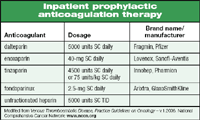Here are first guidelines for VTE in cancer patients
According to oncology experts, active cancer accounts for about 20%of all new venous thromboembolic events (VTE), and cancer patientshave a four-to sevenfold higher risk for VTE. Add to that the riskof being treated with chemotherapy drugs that may haveclot-producing properties of their own, and you are talking about aserious risk for a deadly condition. With this in mind, theNational Comprehensive Cancer Network (NCCN) recently released newguidelines to help oncology practitioners prevent, diagnose, andtreat VTE.
According to oncology experts, active cancer accounts for about 20% of all new venous thromboembolic events (VTE), and cancer patients have a four-to sevenfold higher risk for VTE. Add to that the risk of being treated with chemotherapy drugs that may have clot-producing properties of their own, and you are talking about a serious risk for a deadly condition. With this in mind, the National Comprehensive Cancer Network (NCCN) recently released new guidelines to help oncology practitioners prevent, diagnose, and treat VTE.
"It is extremely important to have guidelines related to VTE in this specific patient population," said Latha Radhakrishnan, Pharm.D., clinical oncology pharmacist and clinical assistant professor at the University of Illinois College of Pharmacy. She explained that chemotherapy, hormonal therapy, and the disease itself put cancer patients at higher risk than the general population for thromboembolic events.

For patients who will eventually switch to long-term warfarin, parenteral therapy should be discontinued when the International Normalized Ratio (INR) falls between 2.0 and 3.0 for two consecutive days. Research has shown that heparin therapy should continue for a minimum of five days.
Monotherapy with an LMWH is the preferred long-term treatment in patients with proximal DVT or PE and prevention of recurrent VTE in patients with advanced or meta-static cancer. Warfarin is another option. Long-term anticoagulation should continue for a minimum of three to six months for DVT and six to 12 months for PE. When cancer is active, or a patient has persistent risk factors, clinicians should consider continuing treatment indefinitely. Catheter-associated thrombosis should be treated as long as the catheter remains in place and for one to three months after it's removed.
Radhakrishnan pointed out that, although these guidelines are directed more toward inpatients with cancer, many patients are receiving chemotherapy as outpatients. "We are also diagnosing VTEs in clinics," she said. "Unless patients have a known history of DVTs or PEs, outpatient cancer patients are typically not receiving prophylaxis with LMWHs." However, she explained, once a VTE is treated in-house, the patients are often followed up in an outpatient oncology clinic. Therefore, she believes, "there should be strict guidelines for both inpatient and outpatient management."
NCCN has included VTE as part of its Practice Guidelines in Oncology, which can be accessed at http://www.nccn.org/ under Supportive Care.